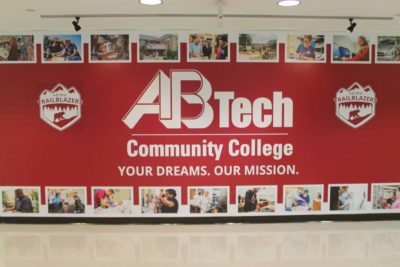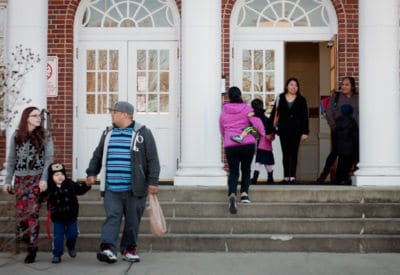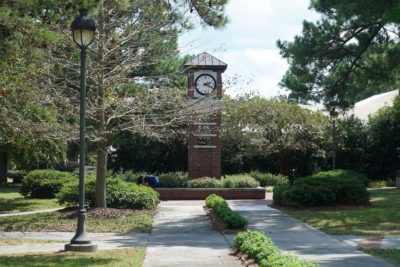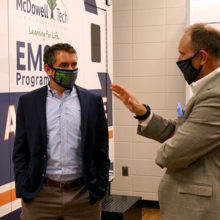This is a copy of the Awake58 newsletter originally sent on Monday, September 10, 2018. Click here to subscribe.
Awake58: Free College
Hello, it’s Nation. Welcome to Awake58. This week we are documenting a visit to Fayetteville Tech where the college is trying to meet an ever-moving target of what “community” means to the students. We also briefly explore the debate around free college programs. Finally, if you work at a community college, I want to know if you work a second job to get by.
This week I have been in Asheville attending the North Carolina Association of Community College Trustees meeting. I had the opportunity to visit with several folks from across the state who related their own experience with the launch of the newsletter, our community college blitz, and the formal launch of our postsecondary coverage.
I was asked by more than person about “our angle” on the blitz. They wondered what stories we were looking for. They asked what we hope to write and what our end goal is. This is a great question, and I will tell you what I told them — our visits were about beginning to define the stories we are looking for, our research, and the work ahead for us. It was the beginning of our journey, not the end.
Thank you for joining us on this effort and trusting us to lift up the stories and issues which will define the community college system moving forward. This newsletter is part of the journey, but it is only successful if it is treated as a conversation.
We’ve heard a lot from you about the importance of telling the story of the community colleges in order to turn around perceptions, boost awareness, and provide people with a clear understanding of the value of community colleges.
President Peter Hans included storytelling as a priority in his speech to the trustees on Friday morning when he articulated the need to tell the story of the system as part of his vision for the system moving forward.
So, with that in mind, this week’s big question is to turn the question of the angle around to you — what is the story of our community colleges?
We’re listening.
EdNC Picks
Hitting a moving target at Fayetteville Technical Community College
Robert Kinlaw raises an interesting question in this piece around Fayetteville Technical Community College — if community colleges are intended to reflect the workforce needs of the local community, how does a school which serves a military community with many transplants play that role?
From high schools into the workforce: Rockingham Community College
Alex Granados takes a look at local collaborations which contributed to the launch of an apprenticeship program at Rockingham Community College.
In-Depth with Rob Boisvert: EdNC’s blitz and the role community colleges play in our state, our society
Worth a watch: “These community colleges play really important roles in the fabric of our society.”
The science of wine at Surry Community College
Yasmin Bendaas explores the science of ? at Surry Community College.
We want to know
I was struck by a piece in the New York Times Magazine entitled “Second shift: What teachers are doing to pay their bills.” The author outlines the second (and third) jobs of teachers in the K-12 system. We published our own piece on teachers holding second jobs in North Carolina last year.
It led me to another question for you — if you are a community college faculty or staff member, do you have a second job? We’d love to know. Reply to this email or text NATION to 73224.
Three quick questions with Matt Meyer
Each week we pose three quick questions to a North Carolina leader who is involved with education. This week, we talked to Matt Meyer, Associate VP of Business Engagement and National & International Partnerships at the NC Community College system office.
- How would you define the role of community colleges in North Carolina today?
Matt Meyer: The NC Community Colleges are the Workforce and Economic Calvary in the state, providing students with skills and knowledge that will help them find a job now or their career in the future with local, national, and international-based firms.
- What are some of the promising innovations you have seen within our NC Community College system?
MM: The breadth of work-based learning opportunities provided by our colleges, from undergraduate research experiences and extra-curricular STEM-based competitions, building tiny houses, to registered and non-registered apprenticeship opportunities. Our colleges are constantly looking for ways to provide students with hands-on experiences that they can take to the job.
- The system office is supporting a student to conduct research on the barriers that Hispanic/Latino community college students encounter. What are you hoping to learn from the student’s research?
MM: One of our system’s strategic plan’s themes is student interest and access, and of particular concern, is making sure access for underrepresented populations is free of constraints that potentially could inhibit their success. The student will be interviewing and surveying Hispanic/Latino students and their families about their enrollment experiences and their progress in college. Additionally, the student will also be traveling to Mexico, to see Mexican education institutions and how families there navigate the Mexican education system. Ultimately, we hope his research will help our colleges help North Carolina’s Hispanic and Latino students attain credentials needed for great jobs.
Issue: Free College
Free college programs — ranging from Tennessee Promise to Washington College Bound — are intended to cover the “last dollar” for recipients who meet certain criteria so that college is effectively tuition-free, but are the programs meeting their promise? (Pun intended)
Inside Higher Ed spotlights two new reports which cast a critical eye on the various programs and it is worth your time. Below is an excerpt:
The researchers found that before Tennessee Promise was established, low-income students at the state’s two- and four-year institutions had more than $7,000 in unmet need, even after grants and scholarships. But even with the free college program, the low-income students’ financial needs remained unmet, while the high-income student got an additional $1,500 in state support.
…
“The low-income independent and dependent student receives no money because it’s last dollar,” (Mamie) Voight said. “Their Pell Grant and other aid is already covering tuition … where they really face a notable financial hurdle is in living expenses.”
Mike Krause, executive director of the Tennessee Higher Education Commission, pushed back on the report by noting that the college-going rate of low-income students had gone up and the program shouldn’t be graded solely on dollars awarded.
Krause said as follows: “In Tennessee, our important policy question is, are we creating optimal access for students?”
The reports, on the whole, raise interesting questions around what financial challenges truly exist for students beyond tuition, and who tuition-free programs are helping in the end. After all, as the reports note, tuition is only one portion of the cost facing our students. The whole debate reminds me of a powerful piece from Gail O. Mellow, the President of LaGuardia Community College, which was featured in the New York Times last fall. Mellow addressed some of these challenges in her piece when she wrote, “Community colleges need increased funding, and students need access to more flexible federal and state financial aid, enhanced paid internships and college work-study programs. Improved access to public supports, like food stamps and reduced public transportation fares, would also make a world of difference.”
What do you think about tuition-free programs? What other issues could we attempt to tackle through legislation or philanthropy? Click “reply” and share your thoughts.
By the numbers
23,295 students
In 2016, 23,295 students were enrolled through Tennessee Promise with a total cost of $25.3 million.
$125K annually
By 2019, anyone making under $125,000 annually can receive a tuition-free college education in New York through the Excelsior Scholarship.
75% unaffordable
In 2011, Pew poll found that 75% of people said college is too expensive for most Americans to afford.
7 straight years
Students at two-year colleges have seen an increase in net cost for 7 straight years.
$13.1 Trillion
Outstanding student loan debt in the United States totaled $13.1 trillion at the start of 2017.
A question for you
We have heard from you about the importance of telling the story of community colleges. What is the story of our community colleges to you?
Recommended reading



